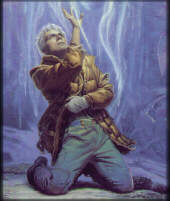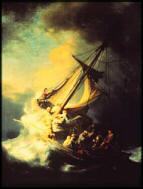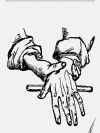

These are the reviews from the first quarter of 1997. For newer reviews, go back to the main book review page.

Cat is a half-breed, half Human and half Hydran. He had possessed strong telepathic powers, but in this book they are in abeyance. He comes to Refuge as part of an academic research team, to study the unique life-form of the planet, the cloud-whales. On arrival, he finds a substantial community of his kin, Hydrans, oppressed by the Tau industrial combine that controls the planet. Cat runs afoul of odious local officials, gets entangled in a Hydran resistance movement, and falls in love. The title of the book, Dreamfall, refers to huge reefs of bio-active material shed by the cloud-whales. Manipulated and mined for profit by Tau, the cloud-whales and the dreamfall are revered by the Hydrans. The plot revolves around this conflict, and also around the kidnapping of a crippled human child by his Hydran therapist.
Dreamfall introduces several interesting themes, but concentrates on the emotional conflicts in Cat and his associates. This is a little unfortunate, because the book short-changes the natural wonders of Refuge, and the political intrigues that helped make Catspaw so engaging. Despite this minor short-coming, Dreamfall is well-paced and exciting, and a good read for any science fiction fan.
Conclusion: Recommended
In writing Creating Killer Web Sites, Siegel is primarily addressing professionals like himself, ready to call on their experience and training in other media, and committed to creating the very best web pages and sites possible. This is not a book for beginners, but anyone with a little experience in creating web sites and using computer graphics tools should benefit from it. Not surprisingly, the printing, typography, layout, and editing of the book are all excellent.
Conclusion: Highly recommended for anyone creating web content
 The notion of risk has been part of human society from ancient times,
but prior to the 1600s, it was a qualitative and mystical notion.
To a medieval peasant, bringing in the harvest late was risky because
nature could choose to send a flood. The average person, or even the
most powerful leaders, were ruled by uncontrollable forces that shifted
the world around them in unpredictable ways.
The notion of risk has been part of human society from ancient times,
but prior to the 1600s, it was a qualitative and mystical notion.
To a medieval peasant, bringing in the harvest late was risky because
nature could choose to send a flood. The average person, or even the
most powerful leaders, were ruled by uncontrollable forces that shifted
the world around them in unpredictable ways.
Against the Gods explores the convoluted intellectual history of risk. From the impersonal and unknowable forces that buffeted our ancestors, to early giants of statistics, to post-war economics, to modern computational models that keep Wall Street humming, Peter Bernstein weaves a fascinating narrative that informs and enlightens. The early chapters of the book are very general, but after the mid-point of its 330 pages the author gradually focuses our attention towards economics and finance. In the last few chapters, the book is almost exclusively concerned with risk as it is understood by economists and investors.
Mr. Bernstein only sparingly employs mathematical equations, diagrams, and charts in the book. Instead, he relies mostly on precise explanations and authoritative commentary. The book is clearly written for the general reader, but every chapter is well-referenced to historical and scholarly sources. Some of the material may seem dauntingly complex, but never vague nor pedantic.
For anybody curious about a critical intellectual facet of the twentieth century, or for the investor trying to understand how the modern approach to risk management arose, Against the Gods is well worth reading.
Conclusion: Recommended
Starplex is the name of a large spaceship, exploring the galaxy by means of instantaneous transit points called 'shortcuts'. Mysteriously placed throughout the galaxy, these shortcuts have already put humans and dolphins into contact with two advanced alien races: the quarrelsome Waldahud and the serene Ib.
The captain of Starplex, one Keith Lansing, struggles to keep his ship and crew intact through a convoluted series of cosmic and political incursions. Mr. Sawyer doesn't pull an punches here - you read the text carefully and you keep up, or he leaves you in the dust. In only 285 pages, Starplex leaps through concepts and action that could probably fill a trilogy.
The writing is solid and concise, the characters reasonably well portrayed, and the structure is creative and enjoyable. Both of the two alien races are okay, although a little more exploration of the intriguing Ibs would have been welcome. Overall, a good read for fans with the right background.
Conclusion: For science fiction fans only - Highly recommended
 Paul Clayton is a relatively new author in the field of historical fiction.
His newest novel is a very enjoyable one, with a good mix of action
and character development set in accurate sixteenth-century locales.
Paul Clayton is a relatively new author in the field of historical fiction.
His newest novel is a very enjoyable one, with a good mix of action
and character development set in accurate sixteenth-century locales.
Calling Crow Nation is the third novel in a series built around the life of an indian named Calling Crow, now a member of the Coosa tribe. War between his tribe and a rival tribe backed by Spanish slavers drives the plot, but the real interest is to be found in the interaction between the Coosa and the crew of the English ship Contempt. The English merchantmen enter the story at the start of their own discord with the Spanish. The relationship between the English trader captain, Samuel Newman, and Calling Crow is the book's deepest theme. Samuel finds out a great deal about himself, and Calling Crow learns a lot about the price of leadership. The stark contrast between Samuel's experiences among the Coosa, and Calling Crow's experiences in England, vividly reminds the reader of the impending tragedies of American colonial expansion.
This novel is full of appealing and repellant characters, none of them painted in the detail devoted to Calling Crow, but all of them interesting and real. Only a few characters are ambiguous, but those particular characters help shape the most poignant scenes in the book. Calling Crow's son, Swordbrought, is a fascinating character whom I hope to see in some of Mr. Clayton's future work. The characters are definitely this book's strength; the plot occasionally gets choppy, and the depiction of the Spanish conquistadors is historically pausible but a little heavy-handed.
Reading the final book in the trilogy about Calling Crow makes understanding his character a little challenging. (The previous two books of the trilogy are Calling Crow and Flight of the Crow.) While background material is smoothly integrated with the rest of the narrative, but the brief descriptions of Calling Crow's experiences before becoming the chief of Coosa town tempt the reader to read its predecessors, too.
Conclusion: Recommended, and highly recommended for fans of historicals
Subtitled Images and Quantities, Evidence and Narrative, this book is about explaining activity, actions, verbs. It is a very difficult subject, but the Prof. is up to the challenge.
First, a little background may be in order. This book is the third in a Prof. Tufte's series about conveying information. The first book, The Visual Display of Quantitative Information (1983), is considered a landmark in the literature of presenting numbers. The second book, Envisioning Information (1990), is a splendid volume about explaining things, objects, collections, nouns. Both of these books are so good, that anybody whose working life includes presenting data to others would be well advised to own both of them. This new book is in the same spirit, and does a wonderful job.
One chapter explores two historical cases in which conveyance of the mechanisms of a process were of deepest importance. In the first case, the London cholera epidemic of 1854, a successful visual explanation stopped the spread of a disease. In the second, the 1986 space shuttle explosion, an unsuccessful attempt to discern a problem allowed the fatal decision to attempt a cold-weather launch.
 The chapter on explaining magic tricks is beautifully crafted to
serve two purposes: examining the illustrations used to teach conjuring
craft as effective visual explanations, and extracting the techniques
magicians use to hide their manipulations as practices to be avoided
in truthful explanations. The picture at left is one of the many
illustrations scattered throughout the book, most of them both
unusual and highly relevant.
The chapter on explaining magic tricks is beautifully crafted to
serve two purposes: examining the illustrations used to teach conjuring
craft as effective visual explanations, and extracting the techniques
magicians use to hide their manipulations as practices to be avoided
in truthful explanations. The picture at left is one of the many
illustrations scattered throughout the book, most of them both
unusual and highly relevant.
Prof. Tufte's books are justly famous for the pithy, precise language and insightful points. For example, in the quote below, the author is critiqueing scientific visualizations that distort or elide contextual scale information (p. 23)
More generally, when scientific images become dequantified, the language of analysis may drift toward credulous descriptions of form, pattern, and configuration - rather than answers to the questions How many? How often? Where? How much? At what rate?
This review describes less than half of the topics that Visual Explanations covers in only 150 pages. If your work includes explaining processes, mechanisms, or actions, you should read this book.
Conclusion: Highly recommended
 The new edition of
Programming Perl explains all the facilities of the language
concisely and clearly. The text is very readable, the examples well-written
and plentiful, and the structure of the book is first rate.
The new edition of
Programming Perl explains all the facilities of the language
concisely and clearly. The text is very readable, the examples well-written
and plentiful, and the structure of the book is first rate.
The only flaw, if it can be called one, with this book is the breadth and depth of coverage it provides. Not intended as a beginner's tutorial, Programmer Perl presents a very wide range of topics in considerable technical detail. Programming novices may find some of the material too deep, although experts will relish it. Overall, this book is a fine example of a language guide, and is sure to be valued by a great many dedicated programmers. Readers seeking a general introduction to the language would be better served by the companion volume Learning Perl (1-56592-042-2).
Conclusion: Highly recommended for computer programmers, not suitable for general readers.
[Ziring MicroWeb Home] [Neal Ziring] [Julie Ziring] [Ziring Guestbook]
This page written by Neal Ziring, content last modified 1/17/97.